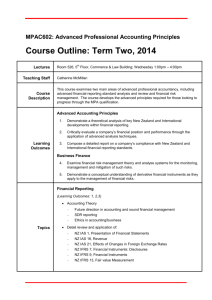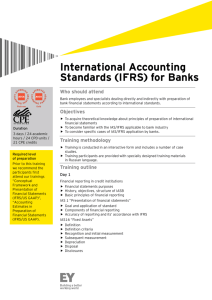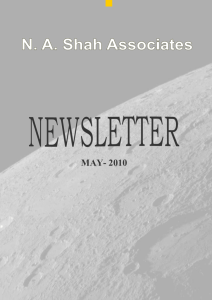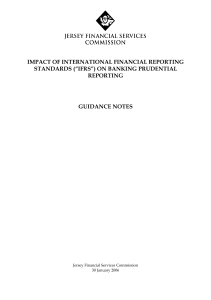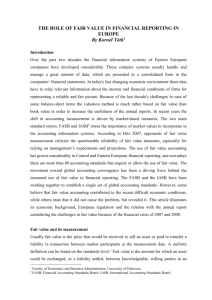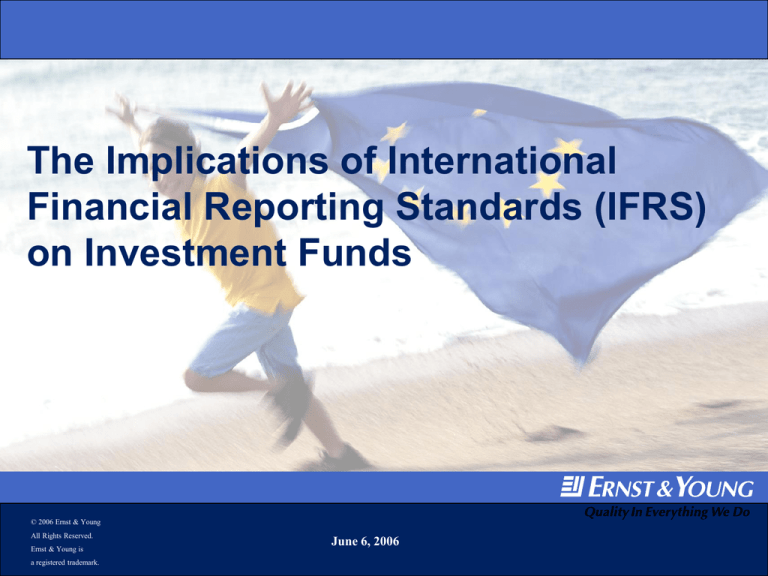
The Implications of International
Financial Reporting Standards (IFRS)
on Investment Funds
© 2006 Ernst & Young
All Rights Reserved.
Ernst & Young is
a registered trademark.
June 6, 2006
Agenda
A.
Background & Framework
B.
Executive Summary of IFRS Issues Affecting Investment Funds
C.
Specific IFRS affecting Investment Funds
D.
Impact of IFRS on the work of the auditor
E.
Relationship between the auditor and the investment fund regulator
A. Background & Framework
EU Regulation
EU Regulation adopted by EU Parliament on 7 June 2002:
3
Who?
All European companies listed on a stock
exchange
What?
Consolidated annual accounts
When?
Financial periods commencing 1 January 2005
(including at a minimum comparatives for 2004)
IFRS Required for Investment Funds?
• IFRS is obligatory when listed & only when consolidated
accounts are required, however
– Member states have the option to permit/oblige
application of IFRS
– Requirements of supervisors of stock exchanges
– Local standard setters are gradually implementing IFRS
– More and more funds apply IFRS
– IFRS are becoming an indication for quality of reporting
– Supervisors/regulators are investigating the impact on
regulations and reporting requirements
4
IFRS Framework
• IFRS comprise International Accounting Standards,
International Financial Reporting Standards and
associated pronouncements and interpretations issued by
the International Accounting Standards Board (IASB)
5
IFRS Framework (cont’d)
• IFRS represent a comprehensive set of standards setting
rigid disclosure requirements and accounting rules
• Significant development over past 5/10 years
• More widely accepted and now endorsed by the European
Union
• Judgment based
• GAAP convergence – IASB/FASB
• Limited industry specific guidance promulgated by IASB
• Complex measurement and disclosure requirements for
financial instruments
6
Terminology
• IAS – International Accounting Standard
• IFRS – International Financial Reporting Standard
• ISA – International Standard on Auditing
7
B. Executive Summary of IFRS Issues
Affecting Investment Funds
Issues affecting investment funds
• No separate standards for investment funds
• No illustrative financials or disclosures promulgated by IASB for
investment funds
• Format of financial statements established by IAS 1 – Presentation of
Financial Statements
• IAS 7 – Cash Flow Statement
• IAS 14 – Segmental Reporting
• IAS 21 – The Effects of Changes in Foreign Exchange Rates
• IAS 24 – Related Party Disclosures
• IAS 27 – Consolidation
9
Issues affecting investment funds (cont’d)
• IAS 33 – Earnings per share (EPS)
• IAS 38 – Accounting for formation expenses
• IAS 32 and IAS 39 establish significant accounting and
disclosure requirements affecting investment funds for
financial instruments (including the classification of
redeemable shares as liabilities)
10
C. Specific IFRS affecting Investment
Funds
IAS 1 – Presentation of Financial
Statements
IFRS
12
Balance sheet
Income statement
Statement of changes in shareholders equity
Statement of cash flows
Schedule of investments
Accounting policies and explanatory notes
x
x
x
x
Management report
Comparatives
* Recommended but not obligatory
*
x
2yrs
IAS 7 - Cash Flow Statement
IFRS
•
IAS 7: Cash flows from operating, investing and
financing activities – strict classification requirements
set out in IAS 7
•
Currently no exemptions available
13
IAS 7 - Cash Flow Statement - Issue
•
Lack of exemption inconsistent with other GAAPs (US,
UK and Canadian)
•
Does not provide additional meaningful information
14
IAS 14 – Segmental Reporting
•
Segmental reporting is required for entities whose equity
or debt is publicly traded
•
Business and geographical segments
•
Primary and secondary reporting formats
15
IAS 14 – Segmental Reporting - Issue
•
Current market practice is to disclose portfolio positions
in line with the investment policy as per the fund’s
prospectus
•
May be impossible to define a common classification of
business and geographical segments to be accepted in
various countries since no generally accepted standards
16
IAS 21 – The Effects of Changes in
Foreign Exchange Rates
•
Financial statements should be reported in the
functional currency of the investment fund
•
This represents the currency of the primary economic
environment in which the entity operates
•
Consider the currency in which financing is generated
and the currency from which gains and losses from
investment activities are retained/distributed
17
IAS 21 – The Effects of Changes in
Foreign Exchange Rates – cont’d
•
For most investment funds, the functional currency will
be based on the currency in which the capital of the
fund is designated
•
Exceptions may arise where majority of assets
denominated in another specific currency with no
hedging
•
Consider the currency in which the return is being
provided to investors
•
If functional currency differs from the local currency
disclose this and the reason why
18
IAS 24 - Related Party Disclosures
• A party is related to an entity if:
It controls, is controlled by or is under common control with
the entity
It has an interest in the entity that gives it significant
influence over the entity
It has joint control over the entity
The party is an associate of the entity
The party is a joint venture in which the entity is a venturer
19
IAS 24 - Related Party Disclosures
(cont’d)
• The party is a member of the key management personnel
of the entity
The partner is a close member of the family of any of the
above
The party is an entity controlled, jointly controlled or
significantly influenced by a key member of management
personnel or their close family
The party is a post-employment benefit plan for the benefit
of the employees of the entity
20
IAS 24 - Related Party Disclosures
(cont’d)
• Generally an administrator or custodian would not be
considered a related party
• However, if an employee of the administrator or custodian
was a director or key member of management of the fund,
then they would become related parties
• Key member of management is defined as having the
authority and responsibility for planning, directing and
controlling the activities of the fund
• Disclosure of administration and custody arrangements,
fees and balances may be considered desirable if
considered key contractual arrangements
21
IAS 27 - Consolidation
• If ‘Control’ exists, then consolidate
• IAS 27.13A: A subsidiary is not excluded from
consolidation simply because the investor is a venture
capital organization, mutual fund, unit trust or similar
entity
• Key question for Investment Funds:
Does control exist?
22
IAS 27 - Consolidation (cont’d)
• Control is presumed to exist when the parent owns,
directly or indirectly through subsidiaries, more than half
of the voting power of an entity unless, in exceptional
circumstances, it can be clearly demonstrated that such
ownership does not constitute control
23
IAS 27 - Consolidation (cont’d)
• Control also exists even when the parent owns half or
less of the voting power of an entity when there is
– Power over more than half of the voting rights or power to
govern the financial and operating policies by virtue of an
agreement with other investors
– Power to appoint or remove the majority of the members
of the board of directors or equivalent governing body
and control of the entity is by that board or body; or
– Power to cast the majority of votes at meetings of the
board of directors or equivalent governing body and
control of the entity is by that board or body
24
IAS 27 - Consolidation (cont’d)
• It is not possible to give a general interpretation of
consolidation requirements for investment funds. The
actual situation has to be taken into account. Relevant
elements are
-
25
What are the rights attached to the ordinary shares
(changing the articles of association, change the
investment policy, replace the fund manager,
determine the dividend policy, change the cost
structure)
IAS 27 - Consolidation (cont’d)
– What are the rights attached to the preference shares
(and who owns these shares)
– Do specific provisions exist regarding the share in the
revenues and expenses of the fund, have certain
minimum return guarantees been issued to the
investors
26
IAS 27 - Consolidation - Umbrella Funds
• No specific requirements regarding umbrella funds
included in IFRS
• The fact of being a ‘standard’ umbrella fund does in itself
not lead to a consolidation requirement
• Therefore, being an umbrella fund does not automatically
lead to the application of IFRS
• If a Fund has a subsidiary, for example Indian Tax
subsidiary, etc, there may be a need to consolidate,
therefore IFRS may apply
27
IAS 27 – Consolidation (cont’d) - Issues
• No equivalent to US GAAP Master-Feeder accounting
framework for investment funds
• Feeder must fully consolidate a master fund in which it
holds the majority of the voting shares unless it can
demonstrate that it does not have control
• Expected to be rare that feeder will have voting control
but can demonstrate that it does not have control
28
IAS 27 – Consolidation (cont’d) - Issues
• Feeder that does not have voting control is not required
to consolidate unless it has the ability to control by
contractual agreement
• Certain stock exchanges require such contractual
agreements, therefore most listed feeder funds will need
to consolidate master funds under IFRS
29
IAS 33 – Earnings per share
• Earnings per share should be disclosed by funds whose
ordinary or potentially ordinary shares are publicly
traded
• Presented on face of Income Statement (even if
negative)
• Basic EPS – profit/loss attributable to ordinary
shareholders divided by weighted average number of
ordinary shares outstanding during the period
• Diluted EPS – profit/loss adjusted for effects of all
dilutive potential ordinary shares
30
IAS 33 – Earnings per share - Issue
• Disclosure of EPS not consistent with other GAAPs
(US, UK)
• May completely change the manner in which
performance of a fund is measured
• Does not provide investors with meaningful information
thus it does not enhance presentation and transparency
31
IAS 38 – Intangible Assets
• Formation costs should be expensed as incurred
32
Financial Instruments – IAS 32 & IAS 39
1. SCOPE OF IAS 32 & IAS 39
2. CLASSIFICATION AND MEASUREMENT
3. DISCLOSURES
33
Application Scope
IAS 32
34
Classification of equity as debt
X
Treasury shares (and associated derivatives)
X
IAS 39
Portfolio of securities
X
Loans / trade receivables
X
Liabilities
X
Derivatives
X
Hedging
X
Derecognition of financial assets/liabilities
X
Netting
X
Disclosure
X
Key definitions
• A financial instrument is a contract that gives rise to both
– A financial asset in one enterprise, and
– A financial liability or equity instrument in another
enterprise
• An equity instrument is any contract that results in a
residual interest in the assets of an enterprise after
deducting all of its liabilities
35
Key definitions (cont’d)
A financial asset is any asset that is
• Cash
• A contractual right to
– Receive cash or another financial asset from another
entity
– To exchange financial instruments with another enterprise
under conditions that are potentially favourable
• An equity instrument of another enterprise
• A contract that will or may be settled in the entity’s own equity
instruments
36
Key definitions (cont’d)
A financial liability is any liability that is a contractual
obligation
• To deliver cash or another financial asset, or
• To exchange financial instruments with another enterprise
under conditions that are potentially unfavourable
• A contract that will or may be settled in the entity’s own
equity instruments
37
Key definitions (cont’d)
• Financial instruments issued by the enterprise should be
classified as liabilities or equity instruments according to their
substance
– This depends on whether the instrument contains any of the
elements of a liability as defined in the standard
• Where the instrument contains both liability and equity
components, they should be classified and accounted for
separately
– Interest, dividends, losses and gains should be classified in the
P&L consistently with the balance sheet treatment
38
Key definitions (cont’d)
A derivative is a financial instrument
• Whose value changes in response to the change in a
specified interest rate, security price, commodity price,
foreign exchange rate or similar variable (sometimes called
the ‘underlying’)
• That requires little or no initial net investment, and
• That is settled at a future date
39
Financial Instruments
1. SCOPE OF THE NEW STANDARDS
2. CLASSIFICATION AND MEASUREMENT
3. DISCLOSURES
40
Classification
Category
Main use
Loans and receivables
Conventional loan assets, whether originated
or acquired
Held to maturity
Debt assets acquired by the entity, to be held
to maturity
Held for trading
All derivatives (except for those used in
hedging)
Other items intended to be actively traded
Designated FV through P+L
Any item designated as such at origination,
including liabilities
Available for sale
All assets not in the above categories
Non-trading liabilities
Other liabilities
41
Classification (cont’d)
• Any financial asset or liability may be designated when
initially recognized as a financial asset or liability at fair
value through profit and loss
• Except for investments in equity instruments that do not
have a quoted market price in an active market, and whose
fair value cannot be reliably measured
42
Held-to-maturity
• Financial assets with a fixed maturity and fixed or
determinable payments
• Enterprise has the positive intent and ability to hold to
maturity
• The intent and ability must be assessed at each year end
43
When not classified as « held-to-maturity »
• They are intended to be held for an undefined period
• They would be sold if it became expedient to do so, e.g.
because of market conditions, liquidity needs etc.
• The issuer has the right to settle at significantly below
carrying value, or
• The portfolio is “tainted” (i.e. if in the last three years, the
enterprise sold more than an insignificant amount of heldto-maturity investments)
44
Held-to-maturity (cont’d)
• Held to maturity financial instruments are carried at
amortized cost, using the effective interest method
• If it no longer becomes appropriate to classify an
investment as held-to-maturity, re-measure to fair value
45
Available-for-sale
• These are financial assets that do not fall under any other
classification
• They are measured at fair value, unless fair value cannot
be reliably measured
46
Loans and receivables
•
Created by the enterprise by providing money, goods or
services directly to a debtor
•
Excludes any originated for trading purposes
•
Includes any participations and syndicated loans funded
on origination
•
Loans acquired after origination are classified as trading,
held-to-maturity or available for sale
•
Loans and receivables are measured at amortized cost,
less provision for impairment
47
Accounting for gains and losses
• Financial asset or financial liability at fair value through
profit and loss: (un)realized gains and losses recorded in
the income statement
• Available-for-sale: realized gains and losses in the income
statement. Unrealized gains and losses directly in reserves
• Impairment losses on available-for-sale investments
always included in the income statement
48
Initial Measurement
• All financial assets and liabilities are initially measured at fair
value
• Plus, in the case of financial assets and liabilities not at fair
value through profit or loss
– Transaction costs that are directly attributable to the
acquisition or issue of the financial asset or financial
liability
• IAS 18 - certain financial service fees are an integral part of
the effective interest rate of a financial instrument
49
Subsequent Measurement
Classification
Loans and
receivables
Held to maturity
Fair value
Only if quoted or
designated or hedged item
N/A
Cost / amortised cost
(includes incremental costs of
acquisition, less impairments)
At amortised cost
Held for trading
Designated FV
through P+L
At amortised cost
If FV cannot be reliably measured
(very ltd use only for unquoted
equity instruments and derivatives
thereon)
N/A
Available for sale
If FV cannot be reliably measured
N/A
Non-trading
liabilities
50
Subsequent measurement of financial
liabilities
• Financial liabilities at fair value through profit or loss
(incl. H-f-T) and derivatives that are financial liabilities are
carried at fair value
– Gains and losses are taken to the income statement
• All other financial liabilities are carried at amortised cost
• Again, there are different rules for hedging
51
Measurement of derivatives
Measured at fair value on the balance sheet unless
• Fair value cannot be reliably measured, or
• It is a derivative liability linked to delivery of an unquoted
equity instrument whose fair value cannot be reliably
measured
52
Embedded derivatives
• An embedded derivative should be separated from the
host contract and accounted for as a derivative if
– The economic characteristics and risks of the
embedded derivative are not closely related to those of
the host
– A separate instrument with the same terms as the
embedded satisfies the definition of a derivative, and
– The hybrid is not already measured at fair value with
changes taken to income statement
53
Fair Value
• All financial assets and liabilities are recognized on the
Balance Sheet, including the fair value of derivatives
• All held-for-trading assets are measured at fair value, unless
they cannot be reliably measured
• Fair value represents the amount for which an asset could be
exchanged, or a liability settled, between knowledgeable,
willing parties in an arms length transaction
• Not the amount that would be received or paid in a forced or
distressed sale
• Distinction between instruments quoted in an active market
and those where there is no active market
54
Fair Value (cont’d)
• Listed securities
Value in accordance with quoted prices in active markets
(long – bid price, short – ask price)
• Unlisted securities
Estimation techniques
• Indirect investments
Review of accounting policies and procedures applied by the
Investment Manager to determine fair value
Consolidation may be required (Master/Feeder, controlling
interests in investees)
55
Fair Value (cont’d)
• An active market is one where quoted prices are readily
available and are representative of actual, regular market
transactions
• The valid price is the one quoted in the most advantageous
market that the entity can access
• Stale prices may be adjusted but block discounts are
prohibited
• Quoted prices in an active market may also be inputs for a
valuation model
56
Inactive Markets
• Fair value established using a valuation technique
• Fair value should be determined using the technique most
commonly applied by the market
• Fair value should be determined based on observable data
• Fair value should be based on market inputs and as little
as possible on entity specific inputs
• Valuation techniques should be applied consistently
• Industry valuation principles provide guidance but are not
endorsed by IASB and are not always consistent with IFRS
57
Fair Value - Issues
• Valuation using bid prices does not necessarily provide a
better indication of the fair value
• Bid/ask pricing may lead to confusion if current market
practice is mid-market/last sales price
• Best practice in the US is to use the last quoted sales price
with the bid and mid-market price being methods also
acceptable
• Difference between the ‘offering document’ NAV and
reporting NAV – how do you account for the difference?
• Industry solution – accept mid-market/last sales price as
fair valuation methods?
58
Financial Instruments
1. SCOPE OF THE NEW STANDARDS
2. CLASSIFICATION AND MEASUREMENT
3. DISCLOSURES
59
Financial Instruments: Disclosure &
Presentation
• Main issues:
– Treatment of shareholders’ interests in funds
– Risk management disclosures
60
Financial Instruments: Disclosure &
Presentation (cont’d)
•Under IAS 32 (revised) a financial liability is a contractual
obligation to deliver cash or another financial asset to another
entity
•IAS 32 also designates puttable instruments as financial
liabilities
•Shares redeemable at the option of the holder meet the
definition of a financial liability
61
Financial Instruments: Disclosure &
Presentation (cont’d)
• Redeemable shares issued by open ended funds are
therefore now classified as liabilities
• IAS 32 permits a balance sheet format to be presented for
funds which excludes shareholders equity classified as
liabilities
62
Financial Instruments: Disclosure &
Presentation (cont’d) - Issues
• Financial statements may be difficult to understand and
interpret
• IFRS inconsistent with UK, US and Canadian GAAPs
• What happens to the Statement of Changes in Equity and
Earnings per share?
63
Financial Instruments: Disclosure &
Presentation (cont’d)
Risk management disclosures:
• Aim:
– Enhance understanding
– Assist in assessing amounts, timing and uncertainty of
future cash flows
– Risk management policies and hedging activities
64
Financial Instruments: Disclosure &
Presentation (cont’d)
• IAS 32 and IAS 39 require disclosure of risk exposures,
their impact on the fund and actions taken to mitigate
- Market price risk
- Interest rate risk
- Credit risk
- Liquidity risk
- Currency risk
65
Risk Disclosure
For each identified risk, disclose:
66
•
The exposure and how it arose
•
Objectives, policies and processes for managing
the risk and methods used to measure the risk
•
Any changes from the previous period
•
Exposure at the reporting date including
concentrations of risk
Market Price Risk
• Disclose the investment strategy and how the portfolio is
managed
• Disclose any use of hedging in order to manage market risk
• Disclose the extent to which derivatives are used to provide
exposure to market risk
• Include an analysis of the investment portfolio by country and
industry
• Determine an appropriate threshold for disclosing individual
investment holdings
67
Market Price Risk (cont’d)
• No set requirement for disclosing individual investment
holdings
• However, disclosure needed in order to disclose significant
holdings as concentrations of risk
68
Interest Rate Risk
• Identify interest earning or bearing financial instruments
• Disclose the strategy for managing exposure to interest
bearing instruments
• Disclose the extent to which derivatives are used to
manage or provide exposure
• Disclose effective interest rates
• May require inclusion of a table analyzing the assets and
liabilities of the fund based upon interest rate maturity
dates, however …
• Narrative disclosure may be more meaningful for some
funds
69
Credit Risk
• Disclose concentrations of exposure to credit risk and the
strategy for managing exposures
• Disclose any concentrations of credit risk exposure
70
Liquidity Risk
• Disclose the liquidity of financial instruments held
• Disclose the strategy for investing in non-marketable
investments
• Identify the level of exposure to illiquid investments
• A Fund of Fund should disclose the frequency of
redemptions permitted by investee funds
• Disclose any lock up periods/restrictions on disposal
71
Currency Risk
• Disclose the exposure to other currencies
• Disclose the currency management strategy
• Disclose the use of forward foreign exchange contracts or
other derivatives to manage currency exposures
• Include a currency exposure table analyzing the assets
and liabilities of the fund based on the underlying currency
exposures
• If exposures not material, narrative disclosure is sufficient
72
IFRS 7
• IFRS 7 re-iterates the risk disclosure requirements under
IAS 32 and IAS 39
• New requirement to disclose sensitivity analysis for each
identified market risk at the reporting date
• Show effect of reasonably possible changes in relevant
risk variables
• Disclose methods and assumptions used in preparing
sensitivity analysis and any changes from previous period
• Disclose if sensitivity analysis in unrepresentative of
inherent risk
73
IFRS 7 (cont’d)
• IFRS 7 effective for periods beginning on or after January
1, 2007
• Early application is encouraged
• IFRS 7 re-iterates the risk disclosure requirements under
IAS 32 and IAS 39
• New requirement to disclose sensitivity analysis for each
identified market risk at the reporting date
• Show effect of reasonably possible changes in relevant
risk variables
74
IFRS 7 (cont’d)
• Disclose methods and assumptions used in preparing
sensitivity analysis and any changes from previous period
• Disclose if sensitivity analysis in unrepresentative of
inherent risk
• IFRS 7 effective for periods beginning on or after
January 1, 2007
• Early application is encouraged
75
Legal Reserves
• In certain jurisdictions, there are statutory requirements to
provide for certain reserves and provisions
• Such reserves and provisions are not permitted under
IFRS unless they separately meet the definition as
liabilities
76
IFRS 1 – First Time Adoption
• Final standard published June 19, 2003
• Effective date
– Periods beginning on or after 1 January 2004
• Scope: IFRS 1 applies when an entity adopts IFRS for the
first time by an explicit and unreserved statement of
compliance with IFRS
77
Opening balance sheet approach
Opening IFRS
Balance Sheet
01/01/2004
Date of transition
to IFRS
Comparative
IFRS
Balance Sheet
31/12/2004
31/12/2005
Reporting Date
• The opening IFRS balance sheet is the starting point for
accounting under IFRS
78
Reconciliations
• Three balance sheet reconciliations:
– Closing local GAAP 31 December 2003 b/s and
Opening IFRS 1 January 2004 b/s excluding IAS 39
– Closing local GAAP 31 December 2004 b/s and
Opening IFRS 1 January 2005 b/s
– Closing IFRS 31 December 2004 b/s excluding IAS 39
and Opening IFRS 1 January 2005 b/s including IAS 39
79
D. Impact of IFRS on the work of the
auditor
Impact of IFRS on the work of the auditor
Key considerations:
•Communication to clients of the requirements, time and
resources needed to prepare IFRS footnotes and
disclosures
•Additional clauses inserted into the audit engagement
letter and management representation letter
81
Impact of IFRS on the work of the auditor
(cont’d)
Disclosures and footnotes:
•Significant time required for current year disclosure and preparation of
comparative information if not previously provided
•Additional time required for review of first time adoption reconciliations
(IFRS 1)
•Disclosure checklists need to be completed
•Independent IFRS technical review
82
E. Relationship between the auditor
and the investment fund regulator
Relationship between the auditor and the
investment fund regulator
•Member state local regulator
•Member state fund association
•EFAMA (European Fund and Asset
Management Association) membership and
expert group comprises ‘Big Four’ auditing firms
84
Relationship between the auditor and the
investment fund regulator – (cont’d)
•EFAMA working group
•Objective:
•To analyse the implication of a potential application of
IFRS to European investment funds, in particular with
respect to information benefits to the final retail investor
•Output:
•discussion paper (draft) on IFRS for investment funds in
European Union (March 2006)
85
E&Y Luxembourg Contacts:
Olivier Lemaire, Partner
Phone: + 352 42 22 33 8356
Email: olivier.lemaire@lu.ey.com
Kerry Nichol, Senior Manager
Phone : + 352 42 22 33 8975
Email : kerry-jane.nichol@lu.ey.com
86


